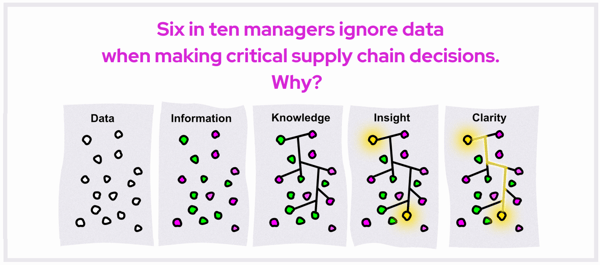IL2000 White Paper Series
Taming your supply chain isn't a data problem
It's a clarity problem.

TAMING YOUR SUPPLY CHAIN ISN'T A DATA PROBLEM
IT'S A CLARITY PROBLEM
The right BI can help you see the one crucial thing you’re missing. We explore examples from real businesses we’ve helped and share 3 principles of best BI practice.
One of the more challenging aspects of supply chain management is that — compared to even a few years ago — we live in a world of considerable logistical uncertainty. The Swiss clock reliability of on-time delivery has given way to volatility. Shipping rates are rising. The days of running a simple, linear supply chain and a traditional shipping playbook have passed. And yet, opportunities are everywhere to do things better — from the game-changing impact of automation and AI to the practical grind of building stronger financial models and smarter tracking tools.
For better or worse, we’re doing business in interesting logistical times. Writing for HBR, a CEO voted as one of the top leaders of small and medium companies in 2021 had this to say about managing a company through uncertainty: “One of the most important business lessons is also the simplest: success is often the result of making more good decisions than bad ones over time. The question is how to do that.”
The question is, indeed, how to do that… And here, of course, the freight train of successful intention hits the cement mixer of an uncertain and unpredictable future.
In this white paper, using real examples, we look at supply chain decision-making clarity: What it is, where it comes from, and how business intelligence forms a vital bridge between data and smart decision-making. But let’s start with a simpler question of why, and the horns of a decision-making dilemma. 
The clarity dilemma and the tyranny of time
So why is it so hard to make clear, objective decisions? Even if you have spreadsheets. Even if you read all the things you should read and talk to all the people you should consult. Of course, most people running a supply chain understand that information and data deliver clarity. We comprehend implicitly that quantifiable, objective analysis begins with numbers. So why not just use spreadsheets to make every important business decision? Especially when it comes to something so metric-driven as a supply chain?
The problem is that finding clarity with data takes time. Real time. And time is a luxury you don’t necessarily have.
In a recent survey conducted by BI-survey.com, almost 60% of participating managers estimated that over half their business decisions were not based on objective data. While there are a few causes, the most cited reason is depressingly simple: a lack of time.
So we find shortcuts and fallbacks:
- Gut instinct: In the pursuit of clarity, a lot of decision-makers lean on gut instinct for quick-fire supply chain decision-making. One significant problem with gut instinct is that this approach is blind to what’s coming next. It brings to mind the story of the inductivist turkey, the tale of an ill-fated (yet delicious) bird who used a gut instinct analysis to gauge his prospects of survival. He concluded that the farmer’s ax was used exclusively for chopping down trees — a theory that proved extremely accurate right up until Thanksgiving morning.
- Memory: Here it’s a simple matter of our human biology often failing us. Our recollection of events is inherently unreliable. According to the American Psychological Association, our decisions are often compromised by “flashbulb memory” — a phenomenon where emotionally significant events are easier to remember than expected outcomes. Of course, we’re stuck with the vagrancies of our dodgy recall on a day-to-day basis. Nevertheless, memory alone is an incredibly unreliable decision-making tool for business.
Data (and the clarity dilemma)
So here’s the clarity dilemma — and it’s an existentially urgent problem. Data offers the clearest pathway to smart-decision making. It is the crucial ingredient that gives us access to a broader frame, an informed perspective, and an objective measure of our success or failure. Data is key to chartering fresh fields of opportunity and to avoiding the farmer’s ax.
- But data takes time to extrapolate.
- It takes more time to verify.
- And it takes yet more time to interpret and analyze.
Somewhere in the spreadsheets and graphs and matrices lies a hidden point of data that can transform your supply chain uncertainty into an efficient freight operation — even a profit center. But most decision-makers simply don’t have the time or resources to find it. Enter the logistics BI dashboard.
How business intelligence gives you clarity
A BI dashboard resolves the too much data, too little time dilemma by simplifying data right down to actionable insight — something you can act on now. At IL2000, when we develop a dashboard for a client, our goal is that every data point we collect supports clarity and guides effective decision-making. Let’s look at a few practical examples of how IL2000 has used BI to help companies make bold, smart, and profitable supply chain decisions.
Download the full white paper below to recognize linear and cyclical trends, discern meaningful patterns, separate fear from uncertainty, and generally make good supply chain decisions!
GET THE BI WHITE PAPER NOW TO TAME YOUR SUPPLY CHAIN

